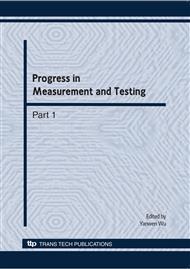[1]
R. Agrawal; T. Imielinski; A. Swami: Mining Association Rules Between Sets of Items in Large Databases", SIGMOD Conference 1993: 207-216.
DOI: 10.1145/170036.170072
Google Scholar
[2]
Jochen Hipp, Ulrich Güntzer, and Gholamreza Nakhaeizadeh. Algorithms for association rule mining - A general survey and comparison. SIGKDD Explorations, 2(2): 1-58, (2000).
DOI: 10.1145/360402.360421
Google Scholar
[3]
Edward R. Omiecinski. Alternative interest measures for mining associations in databases. IEEE Transactions on Knowledge and Data Engineering, 2003, 15(1): 57-69.
DOI: 10.1109/tkde.2003.1161582
Google Scholar
[4]
C. C. Aggarwal and P. S. Yu. A new framework for itemset generation. In PODS 98, Symposium on Principles of Database Systems, pages 18-24, Seattle, WA, USA, (1998).
DOI: 10.1145/275487.275490
Google Scholar
[5]
Piatetsky-Shapiro, G., Discovery, analysis, and presentation of strong rules. Knowledge Discovery in Databases, 1991: pp.229-248.
Google Scholar
[6]
Pang-Ning Tan, Vipin Kumar, and Jaideep Srivastava. Selecting the right objective measure for association analysis. Information Systems, 29(4): 293-313, (2004).
DOI: 10.1016/s0306-4379(03)00072-3
Google Scholar
[7]
Jiawei Han, Jian Pei, Yiwen Yin, and Runying Mao. Mining frequent patterns without candidate generation. Data Mining and Knowledge Discovery 8: 53-87, (2004).
DOI: 10.1023/b:dami.0000005258.31418.83
Google Scholar
[8]
Bayardo, R.J. and Agrawal, R. and Gunopulos, D. Constraint-based rule mining in large, dense databases. Data Mining and Knowledge Discovery , 2000, 4(2): 217-240.
DOI: 10.1109/icde.1999.754924
Google Scholar
[9]
M. J. Zaki. (2001). SPADE: An Efficient Algorithm for Mining Frequent Sequences. Machine Learning Journal, 42, 31-60.
Google Scholar
[10]
Joachims T. Text categorization with support vector machines: learning with many relevant features[C]/ The 10 th European Conference on Machine Learning. New York: Springer, 2007: 137-142.
DOI: 10.1007/bfb0026683
Google Scholar
[11]
YU Hong-mei, YAO Ping-jing. Combined genetic algorithm/ simulated annealing algorithm for large-scale system energy integration [J] . Computers and Chemical Engineering, Elsevier Science Ltd , 2005, 8(24): 2023-(2035).
DOI: 10.1016/s0098-1354(00)00601-3
Google Scholar
[12]
Yang J, Honavar V. Feature Subset Selection using a Genetic Algorithm[J]. IEEE Transaction on Intelligent Systems. 2003, 18(2): 44-49.
DOI: 10.1109/5254.671091
Google Scholar
[13]
LEMPEL R,MORAN S:Stochastic approach for link structure analysis and the TKC effect.
Google Scholar
[14]
KOSALA R, BLOCKEEL H. Web mining research: a survey [J]. SIGKDD Explorations, 2000, 2(1): 1-15.
DOI: 10.1145/360402.360406
Google Scholar
[15]
Kleinberg J. Authoritative sources in a hyperlinked environment [J]. Journal of the ACM, 1998, 46(5): 604-632.
DOI: 10.1145/324133.324140
Google Scholar
[16]
Lawrence S. andGiles C.L. 1999b Text and image meta-search on the web. International Conference on Parallel and Distributed Processing Techniques and Application, (1999).
Google Scholar
[17]
Menczer F, Belew R.K., Willuhn W. Artificial life applied to adaptive information agents. Spring Symposium on Information Gathering from distributed, Heterogeneous Databases, AAIPress, (1995).
Google Scholar
[18]
MoukasA, Amalthea. Iinformation discovery and filtering using a multiagent-evolving ecosystem. Applied Artificial Intelligence, 11(5): 437-457, (1997).
DOI: 10.1080/088395197118127
Google Scholar
[19]
Whitley D. The Genitor algorithm and selective pressure: why rank-based allocation of reproductive trials is best. Proceedings of the third International Conference on Genetic Algorithms, 1989, J.D. Schaffer (Ed), Morgan Kaufmann, pp.116-124.
Google Scholar
[20]
V. Loia and P. Luongo, An evolutionary approach to automatic web page categorization and updating, in Web Intelligence: Research and Development, . Zhong,Y. Yab,J. Liu, andS. Oshuga, Eds, Singapore: Springer-Verlag, 2001, vol. LNCS 2198, pp.292-302.
DOI: 10.1007/3-540-45490-x_35
Google Scholar
[21]
M. Kaya, R. Alhajj, F. Polat, A. Arslan, Efficient automated mining of fuzzy association rules, in: Proc. Internat. Conf. Database and Expert Systems with Applications, (2002).
DOI: 10.1007/3-540-46146-9_14
Google Scholar
[22]
S. Sakurai, Y. Ichimura, A. Suyama, R. Orihara, Inductive learning ofa knowledge dictionary for a text mining system, in: L. Monostori, J. Vancza, M. Ali (Eds. ), Proc. 14th Internat. Conf. Industrial and Engineering Applications ofArti8cial Intelligence and Expert Systems (IEA/AIE 2001), Lecture Notes in Arti8cial Intelligence, vol. 2070, Springer, Berlin, 2001, pp.247-252.
DOI: 10.1007/3-540-45517-5_28
Google Scholar
[23]
J. Wieselthier, G.D. Nguyen, A. Ephremides, On the construction of energy-efficient broadcast and multicast trees in wireless networks, in Proceedings of the IEEE Infocom, Tel Aviv, Israel, 2000, pp.585-594.
DOI: 10.1109/infcom.2000.832232
Google Scholar
[24]
M.X. Cheng et al., Topology control of ad hoc wireless networks for energy efficiency, IEEE Transactions on Computers 2004, 53 (12): 23-34.
Google Scholar
[25]
M. Cardei and D. Z. Du, Improving wireless sensor network lifetime through power aware organization, Wireless Networks, 2005, pp.333-340.
DOI: 10.1007/s11276-005-6615-6
Google Scholar
[26]
Metropolis N, Rosenbluth A.W. Equation of state calculations by fast computing machines[J]. Journal of Chemical Physics, 2003,1087-1092.
Google Scholar
[27]
M. Boughanem, C. Chrisment, J. Mothe, C. S. Dupuy, and L. Tamine. Connectionist and genetic approaches for information retrieval[C], in Soft Computing in Information Retrieval: Techniques and Applications Heidelberg, Germany: Physica-Verlag 2000, 12(50): 102-121.
DOI: 10.1007/978-3-7908-1849-9_8
Google Scholar
[28]
Yang. Y, Honavar, V. Feature subset selection using a genetic algorithm. IEEE Intelligent Systems, 1998, 13(2): 44-49.
DOI: 10.1109/5254.671091
Google Scholar
[29]
Punch, W.F., Goodman, E. D Further research on feature selection and classification using genetic algorithm. Proceedings of the Fifth International Conference on Genetic Algorithm, San Mateo, CA, Morgan Kaufmann, 1993, pp: 557-564.
Google Scholar
[30]
Adriana, P., Veronica L.P. A Genetic Algorithm for Text Classification Rule Induction [J]. Berlin, Heidelberg: Springer-Verlag, LNAI 5212, 2008: 188-203.
Google Scholar
[31]
Kudo, M. Sklansky, K., Comparison of algorithms that select feature for pattern classifier, Pattern Recognition, 2000, 33(2): 25-41.
DOI: 10.1016/s0031-3203(99)00041-2
Google Scholar


